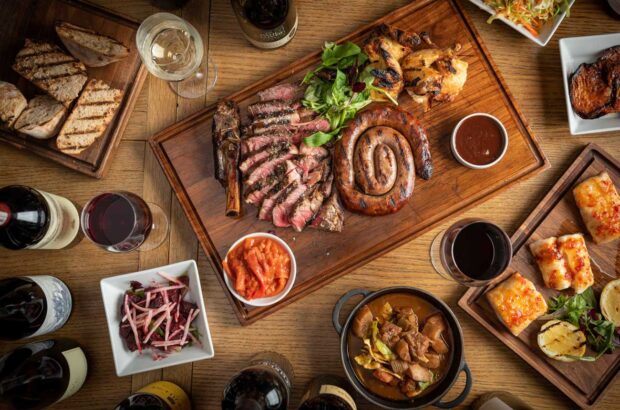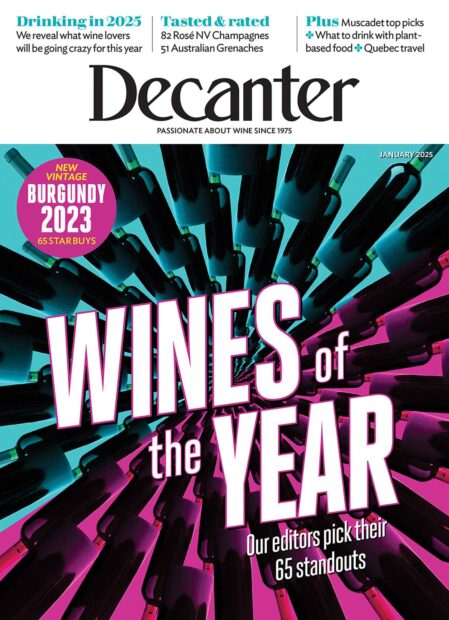Burgundy's new breed of micro-négociant is just as likely to be found in the field or cellar as in a plush office in Beaune, resulting in a fascinating variety of cuvées. Benjamin Lewin MW reports
See Benjamin Lewin MW’s top-rated wines from Burgundy’s micro-négociants
‘What does “negociant” mean in Burgundy? Nothing. Some buy grapes, some mature wine, and some just put their name on the label. But they are all called the same,’ says Olivier Leflaive, who has grown Maison Leflaive to a sizeable operation in Puligny-Montrachet. Leflaive is a forerunner of the new breed of micro-négociants in Burgundy, and takes a typical view of the micro-négociant: ‘I see myself as a winemaker, not a négociant, as I make the wine, from the beginning of vinification through to bottling.’
More than half of Burgundy is made by traditional négociants, whose average size is 10 times that of the average domaine. Owning no vineyards, their expertise tends to be in maturing and blending wine to achieve a certain style. By contrast, domaines make wine only from estate vineyards, and usually on a small scale (average less than 8ha). Between négociants and domaines, some of the best-known producers started as négociants, but then bought vineyards, turning into négociantgrowers, and now their production includes wines made from both estate and purchased grapes. The distinction isn’t always overt, but the word ‘Domaine’ can be used on the label only for production from estate grapes, while ‘Maison’ is often used to describe wines made from grapes which have been purchased.
Bespoke cuvées
The micro-négociants are so-called partly because they function on the small scale of the domaine, but also because they often make micro-cuvées. ‘I make about 60 wines. Many are only one to three barrels. If we were anywhere else it would be a total nonsense, but that’s how it is in Burgundy,’ says Pascal Marchand, who was at Comte Armand in Pommard, and with Domaine de la Vougeraie in Nuits-St-Georges, before striking out on his own in 2006. ‘I’m more of a grower by background,’ he continues. ‘All the wines I made before, I was farming the vineyards from the beginning.’ Like many micro-négociants, Marchand’s emphasis is on the high end, with half of his production in premiers and grands crus. His wines from the Côte de Nuits show an unusual level of refinement.
It’s not just scale that distinguishes micronégociants: most function like domaines in trying to control production from vineyard to bottling. The focus is on representing individual vineyard sites. ‘Big négociants blend many lots, but I don’t have that capacity. I have to get it right at the start,’ says Jeremy Seysses, now Dujac’s winemaker. Dujac Fils et Père is a négociant activity that encompasses Domaine Dujac, which his father created. ‘Most micro-négociants focus on the high end, but we have the domaine [to do that] so I focus on village wines,’ he says, as we taste his Chambolle- Musigny, Morey-St-Denis and Gevrey-Chambertin.
We compare Morey-St-Denis from the domaine and the négociant, and although Seysses says, ‘I don’t really believe a négociant can be as a good as a domaine, because you can’t control the vineyards,’ I would say the distinction is more a difference in style than quality. The négociant wines come out softer, more fruit-forward and less structured. ‘Our domaine wines used to be more like the négociant wines,’ explains Seysses. The domaine has firmed up since we became organic.’
Another producer who sees a difference between domaine and négociant is Nicolas Potel, who created Domaine de Bellene and Maison Roche de Bellene. Wines from the maison are intended to be easier drinking than those from the domaine.
The biggest single factor behind the creation of the micro-négociant breed is the high price of land. Visiting Benjamin Leroux, who has just left Comte Armand in Pommard to run his own maison in Beaune, I tasted his Les Amoureuses from Chambolle-Musigny. ‘Being a négociant means I have the chance to make this wine – what would be my chance of purchasing this vineyard?’ he asks. That’s the driving force for the micro-négociants in a nutshell. Grand cru vineyards on the Côte d’Or cost on average 4m per hectare (£3.2m/ha). ‘As a young grower, no bank would lend you the money to buy land, but as a négociant you’re buying a few barrels here and there,’ explains Seysses. This is a typical entry route into winemaking for newcomers who did not inherit a domaine, or for those who want to extend a small family domaine.
Driven by high land prices, micro-négociants are concentrated in the Côte d’Or, but one interesting exception is Patrick Piuze, making Chablis since 2008, who says, ‘The essence of the place depends on the mosaic of soils; when you realise this, you want to make lots of cuvées, not just one.’ Piuze is an early picker; his wines have moderate alcohol, with a smooth, silky style covered by a generous sheen: he’s quite a revolutionary for Chablis. Leroux has a similar view. ‘I’m aware that 35 cuvées do not make commercial sense, but I’m learning about terroirs.’ Bringing Côte de Beaune sensitivity to the Côte de Nuits, his wines are extremely fine.
Diverse styles
Some domaines add négociant activities, not necessarily just because they want to expand, but to make different types of wine. Domaine de Montille in Volnay is famous for its reds, but Alix de Montille wanted to produce white wine, so the négociant Deux Montille was created in 2003. In fact, winemaking for the domaine now has been moved into the négociant facility in Meursault. The domaine remains focused on reds, but the négociant is mostly white. ‘In Burgundy the négociant has always been regarded as a step down but it needn’t be that way. Here there are no stylistic differences between domaine and négociant, everything is handled in the same way,’ says winemaker Brian Sieve. The whites show a counterpart elegance to the reds, with a similar touch of reserve or austerity when young.
The superficial advantage of a négociant is flexibility: not being bound to specific vineyards, it’s possible in principle to adjust production to market conditions or to compensate for loss of supply resulting from adverse climatic conditions. But in practice it rarely works like that. Most micro-négociants purchase grapes from the same vineyard blocks in most years – in fact, that’s one of their assurances of quality.
And there’s an almost atavistic force driving them back to the land. Most micro-négociants have managed to buy some vineyards (sometimes vineyards from which they previously purchased the grapes). ‘The lines between traditional domaines and négociants have become blurred,’ says Alex Gambal, who started as a classic négociant buying semi-finished wine in 1997, then switched to buying grapes, and now owns some vineyards. His wines extend from Bourgogne to grand cru level, and are characterised by a crisp, clear style. ‘I’ve never bought into the idea that because it’s a domaine it’s better. Plenty of people are good farmers but bad winemakers. That was why the négociant was so important,’ Gambal says.
Influencing viticulture
When you can’t buy the land, you can try to influence viticulture. Micro-négociants’ roles extend from actually farming vineyards to keeping an eye on them and (almost always) determining the date of harvest. ‘There are three different métiers – farming, winemaking and élevage – and a traditional négociant only gets involved with the last,’ says Olivier Bernstein, whose first vintage was 2007. ‘But in my opinion you have to control all three. Some control two, they buy grapes. We are not really a micro-négociant because we are farming and doing the same work as the domaine,’ he says. He produces between four and eight barrels of each of 10 wines, all red. The style follows a finely structured, tight precision, from a light, elegant Chambolle, to a remarkably pure Gevrey-Chambertin, a tight Clos de Bèze, and a Clos Vougeot, with that characteristic fleshiness only just poking out.
One micro-négociant who remains resolutely in the négociant category is Lucien Le Moine, a creation of Mounir and Rotem Saouma, who have been making premiers and grands crus since 1998. Mounir does not believe in trying to micromanage his growers, but trusts them to give him grapes from which he produces some of the most exquisite Burgundies. The winemaking is deceptively simple, but the wines are complicated. Today’s production of 112 barrels is divided into 75 appellations, making an average of about 40 cases of each wine. If I were to try to find some sort of metaphor to describe the winemaking here, I would say it defies gravity, it never gets in the way of expressing terroir.
‘People say I’m a visionary, but I’m not, I’m just making wine in a simple way,’ says Mounir. This ‘simple way’ involves very slow alcoholic fermentation, very late malolactic fermentation, and then long ageing with full lees in barrique. Use of sulphur is restricted to a very low dose a couple of months before bottling. Ageing lasts almost two years, so his wines are usually released late. ‘I saw there was a place for a library of Pinot Noirs. I call it “a library” because we wanted to show that terroir exists,’ is how Mounir explains his objectives, and he makes his point by explaining that there is an intersection where four grands crus from three villages come together. ‘We are going to taste these four side by side, they are completely different. We will go from the very powerful to the weak, because for me, weak is strong.’
Distinctive approach
Mounir’s Vougeot has something of the usual fleshiness, with a warm, nutty background, but the house elegance comes through; the Echézeaux is broader with liquorice on the finish and an impression of roasted nuts; the Grands Echézeaux makes a lighter, more elegant impression, more precise and mineral; finally Musigny is the height of elegance, classic femininity, almost delicate, infinitely refined, the antithesis of Clos Vougeot although it’s only a few yards away. As it happens, all these samples came from barriques of new oak, but this is not at all evident. ‘If a wine comes from new oak without showing the oak, it’s a sign of purity of terroir,’ says Mounir.
Small-scale production is scarcely a new concept in Burgundy, but the focus on micro-cuvées of premiers and grands crus from producers who don’t own the vineyards is novel. These micro-négociants are free to innovate in whatever way they feel best showcases the terroirs. ‘When you inherit a domaine, you are totally influenced by the heritage. I can have a new approach,’ observes Bernstein.
Recent grape shortages resulting from hail and other problems have caused sharp price increases that may change the relationship with land prices. ‘This year will be complicated for some domaines, and there may be land for sale,’ predicts Potel.
So perhaps some of the micro-négociants will turn into domaines. But their success shows it doesn’t matter so much who actually owns the vineyards: what matters is the quality of viticulture and winemaking. Different micro-négociants achieve this in different ways, but Olivier Leflaive’s words at the end of our conversation perhaps speak for all micro-négociants. ‘I am not a négociant, I remind you, I am a winemaker.’
Written by Benjamin Lewin MW







